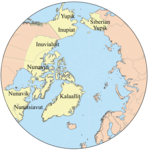Inughuit
 Minik Wallace, Inuk, c. 1890–1918, in New York | |
| Total population | |
|---|---|
| 800 (2010)[1] | |
| Regions with significant populations | |
| Greenland | |
| Languages | |
| Greenlandic (Inuktun), Danish | |
| Religion | |
| Inuit religion, Evangelical Lutheran |
The Inughuit (also spelled Inuhuit), or the Smith Sound Inuit, historically Arctic Highlanders or Polar Eskimos, are Greenlandic Inuit. They are the northernmost group of Inuit and the northernmost people in North America, living in Greenland. Inughuit make up about 1% of the population of Greenland.[2]
Language
The Inughuit speak
Population
Before 1880, their population was estimated to be between 100 and 200 people. From 1880 to 1930, they were estimated to number 250. In 1980, their estimated population was 700,[2] and it rose to 800 in 2010.[1]
History
Early history
The Inughuit are believed to be descended from the
It was during this time that the Inughuit developed their unique language, culture, and fashion — all of which differ significantly from other Inuit. Around this period, the Inughuit also lost the ability and skills to build kayaks or umiaks, which inevitably further restricted travel and contact with other communities.[5]
Modern history
The Inughuit were first contacted by Europeans in 1818,
During the mid-19th century, Inuit from Baffin visited and lived with the Inughuits. The Baffin Inuit reintroduced some technologies lost to the Inughuit such as boats, leisters, and bows and arrows. The Inughuit in turn taught the Baffin Inuit a more advanced form of sled technology. American and European explorers in the 19th and early-20th centuries had extensive contacts with the Inughuits. Explorers Robert Peary and Frederick Cook both had Inughuits in their teams acting as guides. However, more sustained contact with outsiders changed many aspects of Inughuit life by creating a dependence on trade goods and introducing new diseases.[5]
Greenlandic anthropologist and explorer
Settlements
Inughuit people live north of the Arctic Circle on the west coast of Greenland, between 75°—80° N and 58°–74° W. The northernmost settlement was at the village of Etah (at 78° 19' N), but it was abandoned due to the extremely harsh conditions there. The northernmost constant settlement is now Hiurapaluk.
See also
References
- ^ a b c Leonard, Stephen Pax. "The disappearing world of the last of the Arctic hunters." The Guardian. 2 Oct 2010. Retrieved 25 Feb 2012.
- ^ a b c "Inughuit: Orientation." Countries and Their Cultures. Retrieved 25 Feb 2012.
- ^ "Inuktitut, Greenlandic." Ethnologue. Retrieved 25 Feb 2012.
- ^ Martin Appelt; Jens Fog Jensen; Mikkel Myrup; Henning Haack; Mikkel Sørensen; Michelle Taube (2014). The cultural history of the Innaanganeq/Cape York meteorite (PDF) (Report). The Greenland National Museum & Archives. Archived from the original (PDF) on 21 May 2022. Retrieved 7 November 2019.
- ^ ISBN 978-0-8108-6822-9.
- ISBN 978-0-19-976153-1.; (book article)
- ISBN 978-0-393-05150-6., pages=323–5
External links
- The Inughuit tribe of Northern Greenland, BBC
- Recognizing the Inughuit as a Distinct Indigenous People of Greenland and their Right to Return to their Traditional Lands, Inuit Circumpolar Conference Executive Council Resolution 03-02


